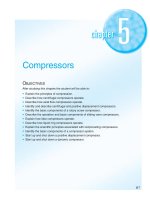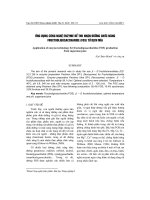Biology technology DNA recombinant technology
Bạn đang xem bản rút gọn của tài liệu. Xem và tải ngay bản đầy đủ của tài liệu tại đây (2.43 MB, 66 trang )
Molecular biotechnologies or
Genetechonology really refers to:
Molecular biology: is the study of biology
at a molecular level.
Molecular genetics: is the field of biology
and genetics that studies the structure and
function of genes at a molecular level.
Genetic engineering: is the direct
manipulation of an organism's genome using
modern DNA technology
Molecular Biology: DNA
Recombinant
DNA recombinant technology used in the isolation or
synthesis and joining together of pieces of DNA
These recombinant DNA molecules can then be introduced
into bacteria, yeasts, or other cells where they can replicate
and function (code for protein or functional RNAs)
TOOL:
Enzymes
Host Cells
Vectors
The Application of DNA Recombinant
Technology
1. Express protein and study protein structure
and its function in vivo; isolate and purify
protein to study in vitro.
2. Use purified protein to make antibodies for
medical purpose and/or make vaccines for
the treatment of disease.
3. Scale-up production, isolation, and
purification of therapeutic proteins (insulin,
…) for use in humans as recombinant DNA
products.
4. Study gene structure, gene sequence, and
gene expression in organs, tissues and
The Application of DNA Recombinant
Technology
5. Find chromosomal location of cloned gene,
determine gene copy number, and study
gene structure.
6. Use in human gene therapy, diagnose human
genetic disorders and infectious disease
conditions.
7. Create transgenic animals and gene knockout animals to study gene function.
8. Create new genetically engineered
microorganisms, animals and plants with a
range of applications from waste-degrading
microorganisms to disease resistant plants
Site-specific recombinases
Site-specific recombinases cleave at specific
sequences and rejoin DNA using a covalent
protein-DNA intermediate.
Tyrosine Recombinases
Serine Recombinases
Site-specific recombinases
1. Serine Recombinases: introduce
double-stranded breaks in DNA and
then swap strands to promote
recombination.
2. Tyrosine Recombinases: break and
rejoin one pair of DNA strands at a
time.
Serine Recombinases
• First , the serine recombinases cleave all four strands
• Second, DNA swap occurs
• Finally, the serine recombinases are liberated and they seal
the DNA strands.
Tyrosine Recombinases
• Cleave and rejoin two DNA strands first, and then
• Cleave and rejoin the other two strands.
Recombinase technology: applications
Site-Specific Recombinases
Phage (λ) genome integration
Recombination always occurs at exactly the same sequence
within two recombination sites (att sites), one (attP) on the
phage DNA, and the other (attB)on the bacterial DNA.
Phage (λ) genome integration
requires
λ Int -a Tyrosine Recombinase
λ Integrase (int) promotes the integration and Excision of a Viral
Genome into the Host Cell Chromosome.
To integrate, λ Int catalyzes recombination between two specific sites
—attachment (att) sites
attP site is on the phage DNA and attB site is on the bacterial genome
attP
attB
attR
attL
DNA sequences of aatB and aatP sites
Serine Recombinases (φ C31-Int)
Two stages of Tn3 transposition
Transposase, responsible (along with the host cell replication machinery)
for the first step, acts at the transposon ends. The site-specific recombinase
(serine recombinase), resolvase, acts at a site, res (red rectangle), within
the duplicated transposon (light blue bars).
Molecular mechanism of
genome circularization
Homologous pairing
of Terminal repeats
Recombination
Base pairing of
Single-strand “Tails”
Ligation
Cre recombinases of P1 phage
Cre binding to the loxP site
Cre/loxP technology
Cre/loxP technology
Forced self excision
Transgenic Plant Journal (2007) Global Science Books
Forced self excision
Transgenic Plant Journal (2007) Global Science Books
Gateway Cloning
Takes a sequence
of interest Entry
Clone, recombines
it with Destination
Vector to produce
a transcriptionally
active Expression
Clone
Chiến lượ c tách dòng gen qua hệ thống Gateway
Spacer sequences of mutant FRTs









